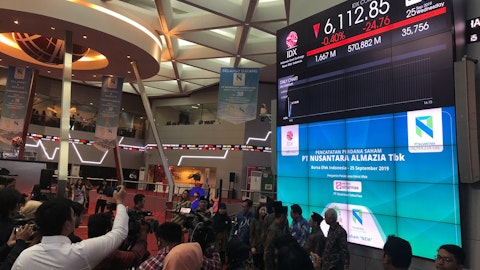PagerDuty, Inc. (NYSE:PD) Q2 2024 Earnings Call Transcript August 31, 2023
PagerDuty, Inc. beats earnings expectations. Reported EPS is $0.19, expectations were $0.1.
Tony Righetti: Good afternoon, and thank you for joining us to discuss PagerDuty’s Second Quarter Fiscal Year 2024 Results. With me on today’s call are Jennifer Tejada, PagerDuty’s Chairperson and Chief Executive Officer; and Howard Wilson, our Chief Financial Officer. Before we begin, let me remind everyone that statements made on this call include forward-looking statements based on the environment as we currently see it, which involve known and unknown risks and uncertainties that cause — that may cause our actual results, performance or achievements to be materially different from those expressed or implied by the forward-looking statements. These forward-looking statements include our growth prospects, future revenue, operating margins, net income, cash balance, and total addressable market, among others, and represent our management’s belief and assumptions only as of the date such statements are made, and we undertake no obligation to update these.
During today’s call, we will discuss non-GAAP financial measures, which are in addition to and not a substitute for or superior to measures of financial performance prepared in accordance with GAAP. A reconciliation between GAAP and non-GAAP financial measures is available in our earnings release. Further information on these and other factors that could cause the company’s financial results to differ materially are included in the filings we make with the Securities and Exchange Commission, including our most recently filed Form 10-K as well as our subsequent filings made with the SEC. With that, I will turn the call over to Jennifer.
Jennifer Tejada: Good afternoon, and thank you for joining us on the call today. PagerDuty delivered solid second quarter results, exceeding our top and bottom line guidance with 19% revenue growth and a non-GAAP operating margin of 13%. Year-over-year operating margin expanded by 1,700 basis points due to disciplined execution as we remain committed to durable profitable growth. Our customers continue to choose the Operations Cloud to protect and grow their digital revenue, reduce operating expenses and more efficiently ensure customer experiences and trust. While customer spending was still measured, our low cost of ownership, quantifiable high return on investment and short payback period resonated as Banco Santander, Cisco Systems, Confluent, DocuSign, Grammarly, HubSpot and NVIDIA chose PagerDuty as their real-time operations platform.
Our enterprise and mid-market customers, which combined account for more than 80% of our ARR remained highly engaged throughout the quarter with nearly 30% expanding their partnership with us. Several customers made 6 and 7 figure investments in the Operations Cloud, contributing to total ARR growth of 17% with travel and hospitality, software and technology and financial services all growing at a faster rate. Despite budgets remaining under pressure, our enterprise customers demonstrated their clear priority to improve their resilience by utilizing our cloud-native platform. The operations cloud’s four core solutions: Incident Response, AIOps, Process Automation and Customer Service Ops, enable them to meet their cost savings objective by automating traditionally manual efforts and accelerating digital transformation, leveraging AI.
Our enterprise segment has been markedly resilient in terms of logo count and dollar based net retention. In Q2, enterprise DBNR and logo growth rates were above the company averages and also performed better on a year-over-year basis. We continue to align our strategy, product development and go-to-market efforts around capturing enterprise demand to grow profitably. Enterprise customers are increasingly interested in leveraging automation through the operations cloud to improve the productivity and efficiency of their technology ecosystems, their processes and their people. During the quarter, a global semiconductor supplier and long-standing customer expanded their investment with us to 7 figures by incorporating our no-code workflow automation to reduce manual work and human error, eliminating tens of millions of dollars in non-value-added annual costs.
PagerDuty’s process automation enabled several teams to build and deploy custom automation workflows across multiple data sources within weeks of implementation to both reduce cost and increase productivity. The Operations Cloud has also become integral to the real-time operations of a global financial institution. After replacing Point Solutions with PagerDuty earlier this year, the customer who is among our million dollar cohort continued to grow with us by using incident response, AIOps, and process automation in concert, we are expecting to generate savings over $16 million per year. While many of the macro trends we mentioned last quarter persist, we adapted quickly to these conditions and increased pipeline generation and conversion. In addition, we improved large contract execution and stabilized the number of paid customers.
As evidence of the value of the PagerDuty platform, total customers free and paid grew by 19% year-over-year. We continue to expand our competitive advantage through innovation taking a long-term view on capturing our $38 billion TAM and our ability to transform our customers’ operations is being recognized. Year-to-date, Gartner Hype Cycle reports have recognized PagerDuty across nine unique categories, highlighting the breadth of our offerings. We were also named a leader in Forrester’s first ever process centric AIOps wave, making it the third industry AIOps evaluation to put us in the leader category. Achieving FedRAMP In Process status was an additional milestone reached during Q2 and which will enable U.S. federal government agencies and large commercial customers who require FedRAMP to partner with us and streamline their operations and automate unplanned work.
We remain bullish on the opportunities that generative AI brings to our business. It’s rapid adoption and incorporation into the tech toolkit creates two tailwinds for us: First, its ease of use and broad applicability, lower the barriers to building software and more software equates to greater complexity for companies already struggling to cross the operations chasm. Second, generative AI makes the benefits of automation very tangible for companies. The time savings and cost efficiencies are immediate and concrete, and in a macro client where CIOs are being asked to do more with less, the early wins they see with generative AI are driving leaders to ask what else across their business can be automated. The three degenerative AI use cases we shared last quarter offer intuitive examples of the value unlock that comes with AI and automation more broadly.
AI generated status updates and postmortems are now in customer preview. Our AI-generated runbooks offering, which offers natural language prompts combined with automated prompt tuning is now in early access. All three have been well received by our customers and additional use cases are in development. During its first quarter of availability, our latest version of AIOps exceeded our goals with nearly 100 customers opting into our consumption based package. While still early, the expanded capabilities, including AI-enabled global event orchestration, now support both the developer community as well as centralized teams in network operations site reliability engineering and ITOps. Making the operations cloud the standard for different types of high value critical work across the enterprise is key to us revolutionizing operations.
This quarter, we made further progress through the general availability of custom fields and incident workflow templates. With custom fields, we are widening the aperture of use cases for the operations cloud to teams beyond engineering. For example, customer service teams can define an incident type in order to trigger different types of incident workflows, a security team can trigger an incident for a data breach, which will loop in PR and legal. These capabilities mark exciting progress against our long-term vision for PagerDuty’s offering across the enterprise and expand the monetization opportunity for our higher value plans. Additionally, the powerful new analytics capabilities we announced today are available to all paying customers.
PagerDuty’s insight reports provide teams with more granular visibility and control over operational health and maturity, specifically designed with technology executives in mind. These reports provide leaders with real-time critical insights into the state of their operations, including which services are most impacted, achievement against SLAs and overall team health. Automation is also embedded in how PagerDuty empowers mission driven teams to build a more equitable world and sustainable future. This quarter, our social impact team leveraged our no-code workflow builder to automate the capture of employee volunteer hours. Our employees remain invested in their communities, posting more than 80% volunteer participation in the quarter. For the second consecutive year, the San Francisco Business Times recognized PagerDuty as one of the top 100 corporate philanthropists in the Bay Area.
Additionally, PagerDuty was named 2023 top 50 inspiring workplace in North America and as one of Fortune’s best workplaces in the Bay Area and Best Workplaces for Millennials. Moving forward, we intend to maintain the go-to-market and product development rigor that enabled us to deliver non-GAAP profitable growth during the second quarter. Gartner estimates spending on cloud application and services will exceed $240 billion in 2024. And we believe this indicates a significantly larger opportunity available to us long term. We are successfully undertaking more strategic conversations within enterprises, standardizing the operations cloud go-to-market playbooks and accelerating awareness through demand gen and partnership events. The structural initiatives implemented throughout the past two years codified a profitable framework for delivering consistent innovation required by businesses to cross the operations CASM.
We believe this positions us to monetize the operations cloud and achieve our long-term operating targets. I want to thank our customers for their loyalty and our teams for their focus and enduring commitment to championing our customers. With that, I’ll turn the call to Howard and look forward to your questions.
Howard Wilson: Thank you, Jen, and good day to everyone joining us on this afternoon’s call. In Q2, we delivered solid results ahead of both our revenue and non-GAAP operating margin guidance as we continue to adjust to the economic environment. Our enterprise and mid-market customers where the cost and risk of operational failure is high, continue to choose the PagerDuty Operations Cloud to mature, modernize and scale their digital businesses. Unless otherwise stated, all references to our expenses and operating results are on a non-GAAP basis, and I’ll reconcile to our GAAP results in the earnings release that was posted before the call. Revenue was $108 million in the second quarter, up 19% year-over-year. The contribution from international was 27% of total revenues, an increase from the 23% seen in Q2 of last year.
We delivered 114% dollar-based net retention in Q2 compared to 124% in the same period one year ago. Our DBNR expectation for the second half remains at or above 110%. Customers spending over $100,000 in annual recurring revenue grew to $773 million, up 12% from a year ago. Total paid customers increased sequentially by $57 to 15,146 (ph). In Q2 of the prior year, the count was 15,174. Free and paid customers on our platform grew to over 26,000 and an increase of approximately 19% compared to Q2 of last year. Q2 gross margin was 86% at the top end of our target range of 84% to 86%. Operating income improved 1,700 basis points to $14 million or 13% of revenue compared to a loss of $3 million or negative 4% of revenue in the same quarter last year.
In addition to revenue outperformance, this metric was above our initial expectations due to a few million dollars of nonrecurring expenses related to consulting engagements and marketing program spend shifting from Q2 to Q3. In terms of cash flow for the quarter, cash from operations was $11 million or 10% of revenue, and free cash flow was $9 million or 8% of revenue. The shift of expenses I just mentioned also led to an improvement to free cash flow. As a result, we now anticipate Q3 to be below point this year for cash, but remained positive. Turning to the balance sheet. We ended the quarter with $504 million in cash, cash equivalents and investments. Total deferred revenue ended the quarter at $197 million, up 16% year-over-year. The seasonality of our renewals along with our standard co-terming practices, creates fluctuations in our quarterly billings.
In quarters where we have a high volume of smaller expansion transactions while not impacting contractual arrangements does reduce the predictable nature of billings. This has been evident over the past two quarters and we expect to see this trend of a high volume of smaller transactions continue. To provide additional transparency during this period, we will be providing more frequent updates on quarter end annual recurring revenue or ARR. ARR exiting Q2 grew 17% year-over-year to $431 million. For consistency with prior calls, quarterly calculated billings were $102 million, an increase of 11% year-over-year and below the range of 12% to 15% provided during last quarter’s call. On a trailing 12-months basis, billings were $433 million, an increase of 20% compared to a year ago and in line with our estimates.
With respect to Q3, we expect calculated billings growth to be between 8% and 10% and trading 12 months billings growth to be approximately 14% (ph). Turning to our guidance. For the third quarter of fiscal 2024, we expect revenue in the range of $106.5 million to $108.5 million, representing a growth rate of 13% to 15% and net income per diluted share attributable to Page Duty Inc. in the range of $0.13 to $0.14. This implies an operating margin of 8% to 9%. For the full fiscal year 2024 revenue is expected to be in the range of $426 million to $430 million, representing a growth rate of 15% to 16%. This compares to the range previously provided of $425 million to $430 million. And net income for diluted share attributable to PagerDuty, Inc.
remains between $0.60 and $0.65. This implies an operating margin of 11% to 12%. We remain focused on the long term, building on the trust our customers place in us and committed to durable profitable growth. I would like to recognize our teams across the globe for their dedication to our vision and for providing the continuous innovation required to transform critical work and revolutionize operations. With that, I will open up the call for Q&A.
Operator: Okay. Thank you. And to our analysts on the line, please feel free to raise your hand. We’ll begin by going to Keith Weiss with Morgan Stanley. Keith, please feel free to ahead.
Unidentified Participant: Hi. Good afternoon. This is Fiona (ph) on for Sanjit Sing and Keith Weiss. Thank you for taking the question. I wanted to ask on the new SKU called AIOps, which was announced last quarter. The interesting thing about the SKU is that it’s price on consumption and not seats, and I think that you noted that you had about 100 new customers up taking the SKU in the quarter. So curious about any early learnings that you’ve seen about bringing this to market? How does the co-selling motion work with the rest of the product portfolio and anything else that might be of note? Thank you.
See also 25 Countries with the Highest Internet Penetration Rates in 2023 and 19 Countries Where Drones are Banned.
Q&A Session
Follow Pagerduty Inc. (NYSE:PD)
Follow Pagerduty Inc. (NYSE:PD)
Jennifer Tejada: Thanks for the question. It’s a very natural selling motion. I think one of the competitive advantages of AIOps compared to point solutions that are in the market or older kind of legacy event management solutions is that it not only enables AI driven analysis and event orchestration, but because it’s deeply integrated into the Operations Cloud, it also ensures action on the back of that analysis, which is not the case for other AI solutions. So it’s a natural part of the incident response value chain and even more importantly, a welcome insight connected into the automation that we deliver through the combination of incident response, AI Ops, process automation and even customer service ops. So it’s actually a real natural step in the selling motion and, in fact, a good door opener to talk further about process automation and even customer service operations.
You nail that the reason that we’re in market with a consumption-based SKU is to learn to understand how the usage patterns may be the same or differ from seat-based licensing, and it’s early, but we’re encouraged by what we see.
Unidentified Participant: Thank you very much.
Jennifer Tejada: Sure.
Operator: Thank you. Next, heading to Rob Oliver with Baird. Rob, please come on forward.
Robert Oliver: Great. Thank you, guys for taking my question. I appreciate it. Good afternoon. I wanted to ask one for you, Jen, just to start. So you mentioned on the call some of the changes that you guys have made to adapt to sort of the changed macro environment, which took you guys by surprise a little bit last quarter. I was wondering if you could provide a little bit of color for us as to what some of those changes or in particular? And then I had a quick follow-up for Howard. Thanks.
Jennifer Tejada: Sure. Well, I’m really proud of our team and their execution throughout the quarter. As you’re aware, we’ve been spending a lot of investment on innovation and shipping that to market and our sales teams have really had to up-level their messaging and having more strategic conversation with C-level buyers as budgets have become more constrained, and there are more and more sort of procurement steps involved in the process. And we were really pleased to see in this quarter stronger large deal transaction flow as well as a number of very strategic operations cloud deals, the one I mentioned with a semiconductor supplier and also with the global financial institution. I mean I spent all of summer visiting with customers.
I saw over 50 customers this summer, and there’s a huge appetite for not only automation, but an operations platform that helps them solve an increasingly material problem, which is reducing the cost and risk associated with material operations failures, whether that’s driven by technical debt operations debt, changes in staffing or security, cybersecurity threats. And so I also think that we’re in the market at the right moment with the right platform for large enterprises that need a highly reliable, resilient operations platform at scale and also are trying to reduce the cost of their overall operations and yet improve the customer experience. And so really telling that entire story to the CIO, the CTO, and even in some cases, the CFO has been important.
And really, I think, trying to articulate the operations Cloud in terms of the business problems that our customers have to solve is an area that we’ve improved in.
Howard Wilson: And maybe I can just add to that as well. Some of the things that we did practically, Rob, were really around fine-tuning some of our approaches to pipeline management. So taking into the account that there would be longer approval cycles and more stakeholders involved. So that led to a different emphasis around both pipeline creation and pipeline management. And we saw encouraging trends with the conversion rates from Q1 to Q2, improving modestly. So it wasn’t a dramatic improvement, but moving in the right direction. And as Jen mentioned, the improvement in large deal flow was actually was also notable. So those things we think are laying the foundation for us to be poised to respond well to an improving economy.





